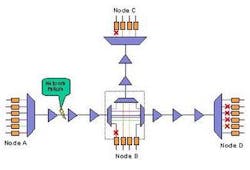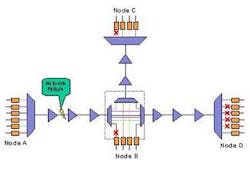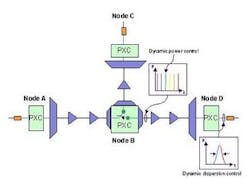Transparent optical networking enabler -- dynamic DWDM
Future DWDM systems must permit changes in the number of channels in the fiber section and the optical connection length in a real-time, fully automated manner.
Ross Saunders
Ceyba Inc.
The last 5 years have seen an unprecedented growth in optical transport bandwidth, fueled by an insatiable demand for Internet Protocol (IP) services. The historic growth of DWDM has been characterized purely by the need for fatter pipes with exponential growth in capacity year on year. The routing and switching intelligence required to guarantee core network availability has traditionally resided in the electrical domain, with SONET Automatic Protection Switching (APS) and IP router Open Shortest Path First (OSPF) mesh restoration capabilities.
So, for the past 5 years, capacity has been king for DWDM deployment. Highest line rate, highest capacity wins all. The paradigm today has now shifted to enabling high revenue generating carrier services and minimizing capital expenditure (CAPEX) and operational expenditure (OPEX) costs in the network. With 80+ channel count per fiber, the cost has shifted from the common equipment (e.g., optical amplifiers) to the optical-electrical-optical (OEO) line cards. So what does this mean for the future of DWDM?
Elimination of OEO conversions by increasing optical reach and enabling optical bypass using optical add/drop multiplexers (OADMs) is key. Future DWDM systems must permit changes in the number of DWDM channels in the fiber section and the optical connection length. Photonic switching means more than sexy 3D micro-machines or liquid crystal wavelength blockers -- the DWDM transport medium must react to connection changes in a real-time, fully automated manner.
Another point often forgotten in the "point-and-click" provisioning nirvana of next-generation systems is system turn-up time. "Point-and-click" does not fault-isolate dirty connectors or erbium-doped fiber amplifier (EDFA) noise figure degradations -- optical performance monitoring does. Next-generation DWDM systems must have a comprehensive suite of diagnostics capabilities that keep PhDs out of the field.
What is dynamic DWDM?
Dynamic DWDM refers to the ability of the DWDM transport system to automatically self-adjust itself to changes in wavelength connectivity. The optical (analog) parameters that must be automatically controlled and monitored are:
1. Per wavelength power levels (at terminals, OADMs, and optical amplifiers).
2. Per wavelength dispersion compensation.
3. Dynamic gain equalization of optical amplifier gain tilt and ripple.
4. Adaptive compensation of polarization-dependent loss (PDL).
5. Adaptive optimization of receiver thresholds to minimize bit error rate (BER).
6. Automatic validation of lightpath signal performance.
7. Pre-emptive warning of signal degradation.
8. Integrated and automated diagnostic capabilities for remote fault identification.
Enabling optically transparent networking
Traditional point-to-point DWDM systems with OEO switching have only supported static DWDM. This has not been an issue, as changes in connection management across the network were completed at the electrical level, with no change in the number of wavelengths or wavelength path length in the fiber optical multiplex section (OMS).
The latest generation of DWDM systems has been designed to minimize cost by the elimination of regenerating OEO conversions. This has been achieved by increasing DWDM reach to extended long haul (ELH, up to 1,500 km) and ultra long haul (ULH, up to 4,000 km) distances and developing more advanced OADMs that can support up to 100% add/drop capability and optical pass-through of traffic at multi-degree junction nodes. The increase in reach, and subsequent loss of OEO electrical performance monitoring (PM), has meant an increased requirement for optical PM to enable fault sectionalization and rapid channel turn-up.
One issue associated with building transparent optical networks with ELH/ULH and multiple intermediate OADM nodes is that upstream OMS failures (fiber cuts or amplifier failures) can potentially cause transient power fluctuations throughout the whole transparent optical network. Dynamic DWDM is essential to ensure that these OMS failures only bring down wavelengths on the specific fiber cross-section affected, and do not cause potentially traffic-affecting power transients on downstream added wavelengths. Dynamic power management of optical amplifers and gain equalizers is essential to ensure this is not the case. A network example is shown in Figure 1.
It is imperative that an OMS failure between nodes A>B only affects wavelength connections originating at node A and terminating at nodes B, C, or D (indicated by a red cross in Figure 1). Co-existing wavelength connections from node B>C, B>D, and C>D should not experience any power transients or resulting bit errors due to this failure scenario.
Dynamic DWDM allows the optical amplifiers in OMS sections B>C and B>D to automatically detect the changes in channel count and adjust their total output powers in microsecond timeframes to ensure transients are adequately suppressed.
Enabling photonic switching
The migration of the transparent optical network to full wavelength agility will make sense as the demand for wavelength services takes off and the optical switching technology matures and costs come down. It is essential that the optical transport layer is ready to support switching as it matures to "prime-time." The key requirements here are:
1. The optical transport layer must support dynamic changes in the number of wavelengths in any OMS.
2. The optical transport layer must support changes in the wavelength routing path across the network.
In this example, the wavelength connection is redirected from node A>C to A>D by switching at node B. The first task of the dynamic DWDM transport is to balance the channel output power at the photonic crossconnect to match the egress OMS levels, using optical automatic gain control. The OMS then adjusts the total output power of each in-line amplifier in section B>D to provide adequate optical signal-to-noise ratio at the channel egress at node D. As the connection from A>C is terminated, the B>C OMS must also reduce its amplifier total power due to the reduction in wavelength count. The dynamic DWDM system then has to perform adaptive tunable dispersion compensation to mitigate the chromatic dispersion of the new wavelength path.
Summary
The evolution of DWDM systems to enable, firstly, transparent optical networking with OADMs and, secondly, photonic switching will rely a dynamic DWDM transport layer. Local control is required to detect power transients and global control to prep the optical line for real-time wavelength connection management.
Ross Saunders is director of product line management for transport and switching at Ceyba Inc. (Ottawa, ON, Canada).

